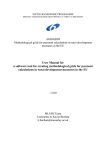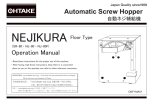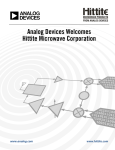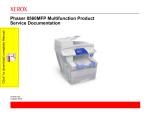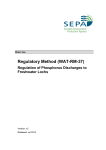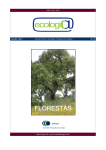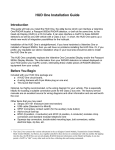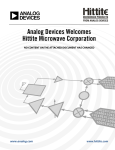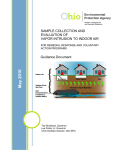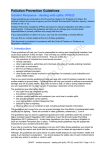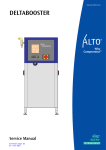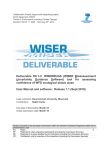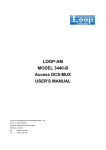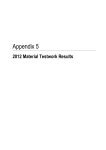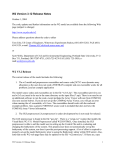Download RT Web GIS User Guide 1_6.pub
Transcript
Defra SE&P Catchment Web GIS User Guide The Rivers Trust, as the umbrella body for rivers trusts in England and Wales, has commissioned a pilot web GIS (Geographic Informa on System) to test sharing of informa on between public, private and third sector stakeholders involved in the Defra Strategic Evidence & Partnership Project. These organisa ons represent the broad spectrum of stakeholders who are engaged in catchment management for delivery of Good Ecological Status under the Water Framework Direc ve. This guide has been prepared to help navigate the contents of the pilot system, poin ng out key Highlights, se ng out the a ributes and detailed informa on about some datasets, and lis ng a full inventory of everything that is contained on the system. Please provide some feedback to the Rivers Trust, before the pilot phase is completed (end November 2011). The web GIS can be accessed via h p://web1.adas.co.uk/rt Highlights Key: N— na onal coverage, R—regional coverage, L—local coverage Rd—Restricted WFD Classification Status and Objectives N WFD Reasons For Failure N Shows overall, ecological, chemical, fish and Shows selected output from the RFF database, invertebrate status and ecological objective for primarily focussed on reasons which Rivers Trusts 2015. can influence, such as barriers, agricultural diffuse pollution and bankside erosion issues. WFD classification status and elements are available to all WFD Codeliverers under Environment Agency statutory license. Covered for Provided by the Environment Agency 2011 under non-commercial RT and Defra SE&P usage under license. Fish Classification Scheme license Z15208 (Rivers Trusts) and Z14888d (SE&P project partners) N Mitigation Measures Nutrient Reduction N Shows FCS2 model results including total EQR Shows predicted reductions in Phosphate and (Environmental Quality Ratio) and breakdown of Sediment per km2 under selected Diffuse Pollution Salmon and Trout scores (observed v predict- mitigation measures. ed). Modelled by ADAS and Environment Agency using the PSYCHIC framework (Phosphate and Sediment Yield Characterisation in Catchments). Provided by the Environment Agency 2011 under non-commercial Compiled and mapped by The Rivers Trust. license Z15208 (Rivers Trusts) and Z14888d (SE&P project partners) Scimap Fine Sediment Risk Model L Ecosystem Services Model R Shows areas of source risk for fine sediment ero- Shows overlapping areas of ecosystem service sion, and indicates concentration of fine sediment provision in the south-west, indicating potential in channels. Rea and Lugg catchments. funders of Paid Ecosystem Services. Scimap output produced by Severn Rivers Trust, Wye & Usk Foundation The ES model is a first draft produced by Westcountry Rivers Trust, and The Rivers Trust. Scimap model developed by the University of and is aimed at provoking discussion and interest rather than providing Durham and available as open source software. a definitive catchment plan at this stage. Potential Barriers to Fish Migration N Consented Discharges N Potential barriers to fish migration taken from the Discharges to rivers and sea under consent by the Environment Agency hydropower opportunities Environment Agency. Shows sewer storm overflows. database. Provided by the Environment Agency 2011 under non-commercial license Z15208 (Rivers Trusts) and Z14888d (SE&P project partners). Provided by the Environment Agency 2011 under non-commercial license Z15208 (Rivers Trusts) and Z14888d (SE&P project partners) Agricultural Census Rd Water Pollution Incidents 2001—2011 N Restricted to licensed individuals on the SE&P Incidents reported to the Environment Agency project only. Use of agricultural statistics is re- 2001—2011, including environmental impact level. stricted by the 1979 Agricultural Statistics Act. Provided by the Environment Agency 2011 under non-commercial license Z15208 (Rivers Trusts) and Z14888d (SE&P project partners). Agricultural statistics provided by Defra under license. HIGHLIGHTS DETAIL INVENTORY Detailed Information for sample Layers WFD Classification Status and Objectives Issues\Pollution\WFD Assessment Coverage: England & Wales Resolution: River waterbody catchments License: WFD Co-deliverers’ Statutory License z6380 Model: Various classification models used for WFD elements Use for: Identifying current and objective WFD status, comparing with range of other datasets Don’t use for: Detailed (field / farm scale) analysis or replacing walk- over surveys as a way of identifying issues and management solutions. Layer Description: The WFD Assessment layers show overall status, chemical and ecological status, fish and invertebrate status, and Good Ecological Status objectives for 2015. Model Inputs: WFD classifications are based on a wide range of EA monitoring datasets, including the fish, invertebrates, water quality and quantity datasets. Classifications have been verified by EA area teams, and are given a confidence score. Limitations: Many water bodies have been classified in the absence of detailed monitoring data. It is important to understand how the classifications have been derived by referring back to the individual elements of the classification, such as the Fish Classification Scheme (FCS2) data, some of which is available in this web GIS. Other detailed monitoring datasets are available on request from your local EA external relations team. Find out more: The Environment Agency are the competent authority for WFD in England & Wales. Find out more about the River Basin Planning process at http://www.environment-agency.gov.uk/research/planning/33106.aspx. UKTAG (the UK Technical Advice Group who formulated much of the UK’s WFD research and modelling guidance) have a very informative website which sets out details of the classification tools, standards and how the classifications are developed http://www.wfduk.org/ HIGHLIGHTS DETAIL INVENTORY Detailed Information for sample Layers WFD Reasons For Failure Issues\Pollution\Reasons For Failure 2011 Coverage: England & Wales Resolution: River waterbody catchments Model: 2011 RFF data v.16.05.2011 Use for: Identifying possible issues in failing waterbodies Don’t use for: Excluding possible issues or identifying issues in water- bodies not classed as failing WFD. Layer Description: Reasons for Failure (Tier 1) - broad reasons for failure. Reasons for Failure (Tier 2) - detailed breakdown of reasons Reasons for Failure (Tier 1 Invasive Species) - waterbodies assessed by EA as failing for invasive species Reasons for Failure (Element fish, Tier 1 Diffuse Source) - waterbodies assessed by EA as failing the fish element of the ecological classification due to diffuse sources of pollution Reasons for Failure (Element fish, Tier 1 Physical Modification) - waterbodies assessed by EA as failing the fish element of the ecological classification due to physical modification of the river channel Reasons for Failure (Tier 2 Arable) - waterbodies assessed by EA as failing due to reasons related to arable farming Reasons for Failure (Tier 2 Poaching) - waterbodies assessed by EA as failing due to reasons related to livestock poaching Model Inputs: Based on national collation of regional and area information from EA teams, following on from investigations. Limitations: This data represents a snapshot of the current understanding of the reasons for failure data at the time of collation. Regions and areas are continuing to collect and record reasons for failure as part of their on-going programme of investigations. Further national collations of the reasons for failure data will be made on an annual basis. When making use of this data for any purpose, but especially for the production of summary statistics, tables, graphs etc. you must: - reference the version of the data used e.g. "This graph was produced using the 2011 RFF data v.16.05.2011" - state whether the information you present is based on a subset of the data e.g. is it all water body types or just rivers, all elements or just phosphate data etc. - state clearly whether your data / analysis is based on the overall number of records of reasons for failure (e.g. 15% of all reasons for failure recorded relate to diffuse source agricultural pollution) or an analysis of the number of water bodies affected by particular reasons for failure (e.g. 30% of failing water bodies have diffuse source agricultural pollution as one of the reasons for failure) Find out more: Dave Baxter, Head of Catchment Management and WFD at the Environment Agency, is the data custodian for this data set HIGHLIGHTS DETAIL INVENTORY Detailed Information for sample Layers Fish Classification Scheme Ecology\Fish Coverage: England & Wales Resolution: Dependent on precision of NFPD grid references License: EA non-commercial license Z15208 (Rivers Trusts) and Z14888d (SE&P project partners) Model: Fish Classification Scheme 2 Use for: Identifying fish species driving final fish classification and therefore starting to identify potential measures for key species Don’t use for: Sole basis for selection of measures — use additional survey data and local knowledge to ensure that fish issues are identified. Layer Description: FCS2 EQR—Ecological Quality Ratio, FCS2 Trout P-values, FCS2 Salmon P-values The Fisheries Classification Scheme (FCS2) assesses the ecological quality of rivers entirely on the basis of the abundance of fish species, as determined by routine survey data. The FCS2 is based on models that describe the relationship between the abundance of 23 fish species, and environmental and pressure variables. For each species, the observed number of fish is compared to the model predictions for what should be present at a comparable site with similar physical characteristics, but at reference conditions. The difference between observed and expected status is expressed as the probability P (0 – 1) of getting an equal or lower numbers of fish at a comparable reference site. (So low P values indicate less fish than would be expected under pristine conditions). Some species are naturally scarce, or patchily distributed, even under reference conditions. Such species will provide a less sensitive indication of ecological quality. The probabilities for each individual species are converted to a combined probability for all species at the survey site. The final site-based outcome therefore has a very specific and objective definition. To comply with WFD terminology, the outcome is called an Ecological Quali- ty Ratio (EQR), which is assigned to one of 5 ecological quality classes. As required by the WFD, the EQR is sensitive to both abundance and species richness. Thus in a lowland river, a moderate abundance of five species may score higher than a high abundance of a single species. Similarly, in an upland stream, a moderate abundance of salmon and trout may score higher than a high abundance of just trout Model Inputs: The models are calibrated from quantitative and semi-quantitative data from over 6000 sites across England and Wales that were surveyed between 2001 and 2005. Data from National Fish Population Database (NFPD). Limitations: The FCS uses fish to classify ecological quality, which is not necessarily the same as classifying the quality of fish populations from a fishery perspective. The mean EQR for a waterbody may be very imprecise, particularly if the number of sites is low, or the variation in EQRs is high. The uncertainty associated with classifying a waterbody from the mean EQR is expressed as a “probability of class”, which is the equivalent of the “confidence of class” used by other WFD tools. Find out more: Graeme Storey is the EA contact for FCS2, Robin Burroughs is the contact for NFPD. HIGHLIGHTS DETAIL INVENTORY Detailed Information for sample Layers Mitigation Measures Nutrient Reduction Rivers Trusts\Management\Defra DWPA User Manual Modelled P,Sed Reduction (PSYCHIC) Coverage: England & Wales Resolution: 1km License: Defra SE&P project (sub-license of ADAS/EA license) Model: Psychic (ADAS) Use for: First pass indication of possible best mitigation measures for tackling diffuse agricultural pollution in catchments Don’t use for: Detailed local (sub-catchment) analysis. Layer Description: Mitigation measures taken from Defra DWPA User Manual, and applied to PSYCHIC model Predicted Phosphate Reduction: Avoid tramlines over winter; Establish in-field grass buffer strips; Loosen compacted soil layers in grassland fields; Reduce overall stocking rates on livestock farms; Establish new hedges. Predicted Sediment Reduction: Establish cover crops in the autumn; Avoid tramlines over winter; Establish in-field grass buffer strips; Loosen compacted soil layers in grassland fields; Reduce poaching; Re-site gateways away from high-risk areas. PSYCHIC is a process-based model of phosphorus (P) and sediment (SS) mobilisation and delivery to watercourses. Modelled transfer pathways include dissolution of soil P, detachment and mobilisation of SS and associated particulate P, incidental losses from manure and fertiliser applications, losses from hard standings, the transport of all the above to watercourses in under drainage (where present) and via surface pathways, and losses of dissolved P from point sources. The model can operate at two spatial scales, although the scientific core is the same in both cases. The model is sensitive to a number of crop and animal husbandry decisions, as well as to environmental factors such as soil type and field slope angle. It is envisaged that the catchment-scale model would provide the first tier of a catchment characterisation study, and would be used as a screening tool to identify areas within the catchment which may be at elevated risk of P loss. This would enable targeted data collection, involving farm visits and stakeholder discussion, which would then be followed up with detailed field-scale modelling. This second tier of modelling would allow the effects of possible mitigation options to be explored. The PSYCHIC model can therefore form the core of catchment studies of P loss mitigation. Model Inputs: At catchment scale, the model uses easily available national scale datasets to infer all necessary input data whilst at field scale, the user is required to supply all necessary data. Datasets used by the national model include agricultural census, Manure Management Database, Soils data (NSRI), climate, connectivity, slope and population. Limitations: The catchment scale model is designed as a catchment characterisation and screening tool, and ADAS recommend that the field scale model be used for identifying mitigation options. Find out more: Contact ADAS for more information on future developments of the PSYCHIC model, refer to Defra DWPA User Manual for details of mitigation measures. HIGHLIGHTS DETAIL INVENTORY Detailed Information for sample Layers Scimap Fine Sediment Risk Model Issues\Pollution\Scimap Erosion Risk Coverage: Rea catchment (Severn RBD). Resolution: 10 metres Model: Scimap (Sensitive Catchment Integrated Modelling and Analysis Platform) Use for: Identifying relative areas of risk within sub-catchments, targeting field survey and walkovers, highlighting potential sediment source areas. Don’t use for: Providing definitive answers, replacing detailed field survey or restricting field work activity. Layer Description: The colours that follow the stream network are indicating the risk categories for fine sediment concentration/ delivery from that stream. It’s calculated as standard deviation around the mean going from green (low risk) to red (high risk) with light orange being the mean for the catchment modelled. If you take a red stream (one that is delivering a disproportionate amount of fine sediment compared to its upstream area, i.e. is accumulating risk quicker then it accumulates dilution) and then look at the underlying model output surrounding the stream output (light blues to brown) you can decipher which parcels of land are most likely the source of sediment. This model output is calculated by multiplying the erosion risk of a parcel of land with a surface flow index. The brown zones are the ones most likely to be delivering effectively telling us where sediment sources are hydrologically connected to a water course (so there is a source, a pathway and a recipient stream). These are the places you would look to put in buffer strips, or carry out contour/gill planting or any other management measure that breaks the connectivity and thus severs the pathway. Model Inputs: 10m digital elevation data (Ordnance Survey Landform Profile); Corine Landcover 2000 (50m resolution), Annual Average Rainfall (Met Office). Limitations: Land cover is the critical input which determines source erosion risk (the model does not consider soil type), and it is costly and difficult to source up to date land cover data for whole catchments. The model is a rainfall runoff model, which calculates surface connectivity, based on slope and accumulation of rainfall runoff downslope. results. Therefore a more detailed (e.g. 5m or 2m) DEM will give more accurate connectivity However, the model does not incorporate local pathways, such as gateways or tracks, which can be a major conduit of sediment to rivers. Find out more: www.scimap.org.uk HIGHLIGHTS DETAIL INVENTORY Detailed Information for sample Layers Ecosystem Services Model Rivers Trusts\Management\Ecosystem Service Provision Coverage: Taw, Torridge, Tamar and Exe (South West RBD). Resolution: 1:250,000 scale Model: Ecosystem Services Multifunctional Land Model Use for: Strategic overview of conflicting areas of ecosystem and food service provision at a catchment scale. Identifying strategic locations where Paid Ecosystem Services approaches may help fund catchment management. Identifying potential funders of ecosystem ser- vices and catchment management work. Don’t use for: Detailed sub-catchment scale land use planning. Layer Description: Seven individual ecosystem service layers are shown, each scoring from 1 (minimum service provision) to 5 (maximum): 1. Provisioning Fresh Water – providing potable water – aimed at Water Company funding 2. Regulating Water Purification – regulating general water quality – aimed at WFD funding 3. Regulating Water (flooding) – regulating flood – aimed at FRM 4. Regulating Water (drought) – regulating drought – aimed at Water Companies 5. Regulating Climate regulation (greenhouse gas sequestration) – aimed at carbon off-setters 6. Cultural Recreation and Tourism – Can people use the area - aimed at visitor payback scheme 7. Supporting Provision of Habitat The models are combined in to a total ecosystem services provision layer, scoring from 1—27, with the higher values representing areas which are important for multifunctional ecosystem services. A Combined Food Produc- tion layer is derived by inverting the combined ecosystem services layer and grading by agricultural land class. This can be compared to a current farming intensity layer based on generalised livestock and arable densities, and a final layer shows the conflict between current intensive agricultural production and the most multifunctional ecosystem services areas. Model Inputs: A very wide range of data were used to create the model layers, most of which is available free of charge to non -commercial users, including Scimap outputs, OS OpenData (various layers), Natural England habitat data, Corine landcover, abstraction locations, waterbody boundaries, source protection zones, flood zones, discharge consents, generalised ag statistics, agricultural land class, biodiversity and ecological network data. Limitations: This is a first draft of a new approach to catchment planning, and should be treated very much as a basis for development of the idea, rather than as a fixed plan at this stage. Modelling at this scale is only suitable for strategic planning, and not detailed farm or sub-catchment scale management planning. Find out more: Nick Paling and Laurence Couldrick at Westcountry Rivers Trust have written a draft paper and their contact details can be found at www.wrt.org HIGHLIGHTS DETAIL INVENTORY Detailed Information for sample Layers Potential Barriers to Fish Migration Issues\Barriers Coverage: England & Wales Resolution: Dependent on precision of NFCDD grid references License: EA non-commercial license Z15208 (Rivers Trusts) and Z14888d (SE&P project partners) Model: Potential Sites of Hydropower Opportunity – AfA175 Use for: Identifying potential barriers to fish migration Don’t use for: Substitute for local knowledge. Layer Description: These data show the location of opportunities for hydropower and the basic environmental sensitivity associated with exploiting them in England and Wales. A total of 25,935 ‘barriers’ are identified and assessed in this project. used to describe sites with sufficient drop to provide a hydropower opportunity. The term ‘barriers’ is They are mostly weirs, but could also be other man-made structures or natural features, such as waterfalls. Model Inputs: Obstructions from the National Flood and Coastal Defence Database. Limitations: Barriers are identified using automated techniques which extract upstream and downstream heights from digital elevation data, and therefore may not be accurate. Further information from local knowledge is needed to identify whether structures present a barrier to all migratory fish species, and whether barriers are full or partial, for example under different flow conditions. Tidal flaps, pumping stations and other key structures may not be included in the dataset. Find out more: Contact EA for further information HIGHLIGHTS DETAIL INVENTORY Detailed Information for sample Layers Consented Discharges Issues\Discharges Coverage: England & Wales Resolution: Dependent on precision of grid references in WIMS License: EA non-commercial license Z15208 (Rivers Trusts) and Z14888d (SE&P project partners) Dataset: Consented Discharges to Controlled Waters Use for: Locating licensed discharges and identifying possible point sources of pollution. Don’t use for: Doesn’t include unlicensed discharges, or any infor- mation on discharge volumes. Layer Description: The Consented Discharges to Controlled Waters dataset contains information on authorised discharges of effluents to the controlled waters. These data have been extracted from the national WIMS (Water Information Management System) database. ‘Controlled waters’ include virtually all freshwaters, ground waters, tidal and coastal waters to a distance of three nautical miles out to sea. Exceptions include small ponds and reservoirs that do not supply water to other watercourses. Public water supply reservoirs are controlled waters. There are over 100,000 Consented Discharges to Controlled Waters for effluent discharges from a wide range of public, private and industrial sectors, discharging into freshwater, estuarine, coastal waters and groundwater in England and Wales. A portion of these are "significant" continuous discharges and require monitoring or inspecting. Sewer Storm Overflows have been extracted as a separate layer to highlight potential threats to bathing water quality from raw sewage entering rivers under high flow conditions. Limitations: Data stored on WIMS is entered from applications made by members of the public, companies and other bodies seeking to obtain authorisation. Applications for consent are assessed and granted or refused based on this assessment. Only when an application is granted will it appear on in the Discharge Consent dataset. WIMS is a live system and it is continuously updated, as such, the dataset represents all the permit data on the system at the time of the extraction. quarterly for release to external sources. Find out more: Contact EA for further information HIGHLIGHTS DETAIL INVENTORY The dataset is updated Detailed Information for sample Layers Agricultural Census Landuse\SE&P Catchments Agricultural Census 2010 & Ag Census Historical 1980 Coverage: SE&P catchments Resolution: 1km License: Defra Confidentiality Statement 13600 (SE&P project partners only) Dataset: Generalised agricultural statistics 2010 & 1980 Use for: Identifying broad agricultural land uses within catch- ments, detecting trends in land use since 1980 Don’t use for: Identifying detailed farm or field-level land use Layer Description: A combination of OS and CEH Landcover data were used to calculate areas of non-agricultural land in each km2, and adjusted using summarised Defra agricultural statistics and Agricultural Land Classification in Wales. Agricultural land use was attributed per km2 to either arable or grassland and the proportions adjusted at parish and district level to ensure that total areas were correct. Livestock densities were calculated by attributing the livestock numbers at parish level to relevant grassland and rough grazing land use areas, and a similar process was undertaken with crops to gain a coverage area per km2, which was summed and checked at parish and district level. Also available are the holdings level Defra agricultural census data for the SE&P catchments (England only), which has been interpolated to a 1km grid, providing a ‘hotspots’ map for key land uses which may cause a potential water quality or ecological impact. These data are restricted to named licensees only and have not been included on the Web GIS at this time. Limitations: Data are generalised to 1km level, so cannot be used to identify individual farms or field land uses (this would be prohibited under The Agricultural Statistics Act 1979). Because of the process of amalgamating holdings level data up to parish or district level, there can be significant local inaccuracies in the km2 datasets, such that livestock numbers and crop areas in small sub-catchments should be verified before being used in local models. Find out more: Contact ADAS and Defra for further information HIGHLIGHTS DETAIL INVENTORY Detailed Information for sample Layers Water Pollution Incidents 2001—2011 Issues\Pollution Coverage: National Resolution: Dependent on precision of grid references in NIRS License: EA non-commercial license Z15208 (Rivers Trusts) and Z14888d (SE&P project partners) Dataset: National Incident Reporting System 2001—2011 Use for: Identifying historical pollution incidents Don’t use for: Ruling out pollution incidents as a cause of ecologi- cal impact—these are only those that the EA are aware of Layer Description: Filtered for Environmental Impact Level to Water, ranging from Category 1 (Major) to Category 4 (No Impact). Limitations: Only records pollution incidents which are known to the Environment Agency, either as a result of investigations, or due to reporting by members of the public, or other agencies. Dataset released quarterly. Find out more: Contact EA for further information HIGHLIGHTS DETAIL INVENTORY Web GIS Data Inventory Layer Descrip on Ecology\Fish\FCS2 EQR Fish Classifica on Scheme Environment Quality Index Ecology\Fish\FCS2 Trout P‐values Fish Classifica on Scheme Trout Results Ecology\Fish\FCS2 Salmon P‐values Fish Classifica on Scheme Salmon Results P values are derived by comparing expected numbers of fish (for a comparable site at reference (pris ne) condi on, with the actual catch at me of survey. High = near refer‐ ence condi ons Low = less fish than expected Issues\Discharges\Current Consented Discharges 2011 Environment Agency's consented discharges database, classified by discharge type Subset of EA Consented Discharges database. Shows con‐ sented sewer storm overflows for water companies and private systems. Combined Sewer Overflows (CSOs) are designed to operate in high rainfall‐runoff situa ons, to prevent backup and overflow of domes c sewerage. Raw sewerage is screened and discharged via a storm overflow system directly in to rivers or the sea. However, a well‐designed system should only discharge at flow level which ensures adequate dilu on. Sites of Hydropower Poten al Environment Agency's hydropower poten al database. Shows river barriers, which provide a sufficient head differ‐ ence for hydropower opportunity, and therefore which may provide a significant barrier to certain species of migratory fish. Not all barriers to fish will be contained in the database, and this is no replacement for local knowledge. Tier 1 broad reasons for failure Refer to EA RFF database RFF 2011 v16.05.2011.xls for more informa on or contact Dave Baxter, Head of Catch‐ ment Management and WFD at the Environment Agency, who is custodian for this dataset. produced using the 2011 RFF data v.16.05.2011 Tier 2 Detailed breakdown of reasons Issues\Discharges\Consented Discharges ‐ Sewer Storm Overflows Issues\Barriers\Poten al Fish Migra on Barriers Issues\Pollu on\Reasons for Failure 2011\Reasons for Failure (Tier 1) Issues\Pollu on\Reasons for Failure 2012\Reasons for Failure (Tier 2) Issues\Pollu on\Reasons for Failure 2013\Reasons for Failure (Tier 1 Invasive Species) Issues\Pollu on\Reasons for Failure 2014\Reasons for Failure (Element fish, Tier 1 Diffuse Source) Issues\Pollu on\Reasons for Failure 2015\Reasons for Failure (Element fish, Tier 1 Physical Modifica on) Detail Showing waterbodies assessed by EA as failing for invasive species Waterbodies assessed by EA as failing the fish element of the ecological classifica on due to diffuse sources of pollu‐ on Waterbodies assessed by EA as failing the fish element of the ecological classifica on due to physical modifica on of the river channel Waterbodies assessed by EA as failing due to reasons related to arable farming Waterbodies assessed by EA as failing due to reasons related to livestock poaching Issues\Pollu on\Reasons for Failure 2016\Reasons for Failure (Tier 2 Arable) Issues\Pollu on\Reasons for Failure 2017\Reasons for Failure (Tier 2 Poaching) Issues\Pollu on\Scimap Erosion Risk\Rea Scimap Fine Risk of fine sediment concentra on / delivery from Sediment Model\Fine Sediment Risk in River Channel ‐ Rea streams. Catchment Red streams are delivering a dispropor onate amount of fine sediment compared to the upstream area (accumula ng risk quicker than dilu on) The brown zones are the ones most likely to be delivering effec vely telling us where sediment sources are hydrologi‐ Issues\Pollu on\Scimap Erosion Risk\Rea Scimap Fine cally connected to a water course (so there is a source, a Areas of fine sediment erosion risk which are hydrologically Sediment Model\Fine Sediment Risk Sources in Rea Catch‐ pathway and a recipient stream). These are the places you connected to the stream network ment would look to put in buffer strips, or carry out contour/gill plan ng or any other management measure that breaks the connec vity and thus severs the pathway. Issues\Pollu on\Scimap Erosion Risk\Lugg Scimap Fine Sediment Model\Fine Sediment Risk in River Channel ‐ Lugg Catchment Risk of fine sediment concentra on / delivery from streams. Issues\Pollu on\WFD Assessment\Chemical Status Issues\Pollu on\WFD Assessment\Ecological Status Issues\Pollu on\WFD Assessment\Overall Status The Lugg Scimap model has some known inaccuracies around the lower lying areas of the catchment, where the model has not resolved the runoff pathways accurately. Issues\Pollu on\Scimap Erosion Risk\Lugg Scimap Fine Areas of fine sediment erosion risk which are hydrologically The model would need to be re‐run using finer resolu on Sediment Model\Fine Sediment Risk Sources in Lugg Catch‐ data to provide a more accurate indica on of risk. connected to the stream network ment Just the waterbodies predicted to be at Good Ecological Issues\Pollu on\WFD Assessment\Overall Objec ve 2015 Status by 2015 Issues\Pollu on\WFD Assessment\Fish Status Issues\Pollu on\WFD Assessment\Invertebrate Status HIGHLIGHTS DETAIL INVENTORY Web GIS Data Inventory Layer Descrip on Detail Issues\Pollu on\Es mated number of proper es per km2 Sep c Tank Es mates (Rea Catchment) not on mains sewerage Issues\Pollu on\Water Pollu on Incidents (2001 ‐ 2011) Incidents reported to the EA and recorded in the Na onal Category 1 (Major) to Category 4 (No Impact) Incidents Repor ng System from 2001 onwards. Issues\Pollu on\Psychic Total Phosphate Load kg/ha (River Phosphate loss from land to rivers, modelled by Psychic P)\River Phosphate Issues\Pollu on\Psychic Total Sediment Load (kg/ha)\River Sediment loss from land to rivers, modelled by Psychic Sediment Issues\Pollu on\NEAPN Total Nitrate Concentra on mg/ Leached nitrate concentra on in rivers, modelled by NEAP‐ N l\Nitrate Concentra on Land Use\SE&P Catchments Agricultural Census 2010\Total Ca le Land Use\SE&P Catchments Agricultural Census 2010\Total Livestock numbers from 2010 Defra Agricultural Census Dairy a ributed to relevant landuse areas in ADAS land use Land Use\SE&P Catchments Agricultural Census 2010\Total model. Shown as numbers per km2. Poultry Land Use\SE&P Catchments Agricultural Census 2010\Total Pigs Land Use\SE&P Catchments Agricultural Census 2010 \Cereals Land Use\SE&P Catchments Agricultural Census 2010 \Maize Crop areas from 2010 Defra Agricultural Census a ributed Land Use\SE&P Catchments Agricultural Census 2010 to relevant landuse areas in ADAS land use model. Shown \Other Arable as ha per km2 Land Use\SE&P Catchments Agricultural Census 2010 \Hor culture Land Use\SE&P Catchments Agricultural Census 2010 \Oilseed Land Use\Agricultural Census Historical ‐ 1980\Total Ca le Restricted license ‐ only available to licensees on Defra SE&P project. Land Use\Agricultural Census Historical ‐ 1980\Total Dairy Livestock numbers from 1980 Defra Agricultural Census Land Use\Agricultural Census Historical ‐ 1980\Total Poul‐ a ributed to relevant landuse areas in ADAS land use model. Shown as numbers per km2. try Land Use\Agricultural Census Historical ‐ 1980\Total Pigs Land Use\Agricultural Census Historical ‐ 1980\Cereals Land Use\Agricultural Census Historical ‐ 1980\Maize Land Use\Agricultural Census Historical ‐ 1980\Other Arable Crop areas from 1980 Defra Agricultural Census a ributed to relevant landuse areas in ADAS land use model. Shown as ha per km2 Land Use\Agricultural Census Historical ‐ 1980\Hor culture Land Use\Agricultural Census Historical ‐ 1980\Oilseed Land Use\Land Cover\LCM 2007 Dominant Land Class Monitoring\Water Quality\2010 Bathing Water Quality Samples\2010 Bathing Water Quality Faecal Coliforms (May to Sept) Monitoring\Water Quality\2011 Bathing Water Quality Samples\2010 Bathing Water Quality Faecal Streptococci (May to Sept) Monitoring\Water Quality\2012 Bathing Water Quality Samples\2010 Bathing Water Quality Total Coliform (May to Sept) Freely available 1km dominant land cover class 2007 from CEH Monitoring\Water Quality\2010 Bathing Water Quality Compliance Each bathing water site receives an annual water quality Higher means the bathing water meets the criteria for the classifica on for every season. This classifica on is calculat‐ stricter UK guideline standards of the Direc ve (includes ed from 20 samples taken during the season. (May to Sept) lower levels of concentra ons and a third parameter (FS)); limits used are TC: ≤500; FC: ≤100; FS: ≤100. The Environment Agency count the number of certain Minimum means that at least 95% of the samples meet the types of bacteria which may indicate the presence of pollu on, mainly from sewage or livestock waste. Total mandatory standards of the Direc ve; limits used are TC: coliforms (TC), faecal coliforms (FC) and faecal streptococci ≤10000; FC: ≤2000; FS: N/A. (FS) are bacteria that are not directly harmful but indicate Fail means that fewer than 95% of the samples meet the the presence of pollu on. An increase in the concentra‐ required mandatory standards of the Direc ve; limits used ons of bacteria indicates a decrease in water quality. All are TC: >10000; FC: >2000; FS: N/A. values are colonies per 100ml of sample. Not sampled indicates that the bathing water was closed Monitoring\Network\WFD Monitoring Sites\Future Moni‐ toring Site Monitoring\Network\WFD Monitoring Sites\Past Monitor‐ ing Site Monitoring will be on‐going here for future River Basin Fish, biology, chemistry or groundwater monitoring Planning cycles Historical monitoring sites which were used for ini al WFD classifica on HIGHLIGHTS DETAIL INVENTORY Web GIS Data Inventory Layer Descrip on Rivers Trusts\Management\Ecosystem Services Provision\Conflict with Current Intensive Agriculture See detailed page in this guide Rivers Trusts\Management\Ecosystem Services Provision\Combined Ecosystem Services Provision See detailed page in this guide Rivers Trusts\Management\Ecosystem Services Provision\7 Ecosystem Services Models\Drinking Water Provision See detailed page in this guide Rivers Trusts\Management\Ecosystem Services Provision\7 Ecosystem Services Models\Water Ecology Provision See detailed page in this guide Rivers Trusts\Management\Ecosystem Services Provision\7 Ecosystem Services Models\Drought Regula on See detailed page in this guide Rivers Trusts\Management\Ecosystem Services Provision\7 Ecosystem Services Models\Flood Risk Management See detailed page in this guide Rivers Trusts\Management\Ecosystem Services Provision\7 Ecosystem Services Models\Climate Regula on See detailed page in this guide Rivers Trusts\Management\Ecosystem Services Provision\7 Ecosystem Services Models\Habitat Provision See detailed page in this guide Rivers Trusts\Management\Ecosystem Services Provision\7 Ecosystem Services Models\Recrea on and Tourism See detailed page in this guide Provision Rivers Trusts\Management\Ecosystem Services Provision\Combined Food Produc on See detailed page in this guide Rivers Trusts\Management\Ecosystem Services Provision\Current Farming Intensity See detailed page in this guide Rivers Trusts\Management\Defra DWPA User Manual Modelled P, Sed Reduc on (PSYCHIC)\Predicted Phosphate See detailed page in this guide Reduc on (g/Ha/yr)\Avoid Tramlines over Winter Rivers Trusts\Management\Defra DWPA User Manual Modelled P, Sed Reduc on (PSYCHIC)\Predicted Phosphate See detailed page in this guide Reduc on (g/Ha/yr)\Establish in‐field grass buffer strips Rivers Trusts\Management\Defra DWPA User Manual Modelled P, Sed Reduc on (PSYCHIC)\Predicted Phosphate See detailed page in this guide Reduc on (g/Ha/yr)\Loosen compacted soil layers in grassland fields Rivers Trusts\Management\Defra DWPA User Manual Modelled P, Sed Reduc on (PSYCHIC)\Predicted Phosphate See detailed page in this guide Reduc on (g/Ha/yr)\Reduce overall stocking rates on livestock farms Rivers Trusts\Management\Defra DWPA User Manual Modelled P, Sed Reduc on (PSYCHIC)\Predicted Phosphate See detailed page in this guide Reduc on (g/Ha/yr)\Establish new hedges Rivers Trusts\Management\Defra DWPA User Manual Modelled P, Sed Reduc on (PSYCHIC)\Predicted Sediment See detailed page in this guide Reduc on (kg/Ha/yr)\Establish cover crops in the autumn Rivers Trusts\Management\Defra DWPA User Manual Modelled P, Sed Reduc on (PSYCHIC)\Predicted Sediment See detailed page in this guide Reduc on (kg/Ha/yr)\Avoid Tramlines over Winter Rivers Trusts\Management\Defra DWPA User Manual Modelled P, Sed Reduc on (PSYCHIC)\Predicted Sediment See detailed page in this guide Reduc on (kg/Ha/yr)\Establish in‐field grass buffer strips Rivers Trusts\Management\Defra DWPA User Manual Modelled P, Sed Reduc on (PSYCHIC)\Predicted Sediment See detailed page in this guide Reduc on (kg/Ha/yr)\Loosen compacted soil layers in grassland fields Rivers Trusts\Management\Defra DWPA User Manual Modelled P, Sed Reduc on (PSYCHIC)\Predicted Sediment See detailed page in this guide Reduc on (kg/Ha/yr)\Reduce Poaching Rivers Trusts\Management\Defra DWPA User Manual Modelled P, Sed Reduc on (PSYCHIC)\Predicted Sediment See detailed page in this guide Reduc on (kg/Ha/yr)\Re‐site gateways away from high‐risk areas HIGHLIGHTS DETAIL INVENTORY Web GIS Data Inventory Layer Descrip on Rivers Trusts\Management\Rea Bankside Sediment Source Priori es\Bankside Poaching Priority Rivers Trusts\Management\Rea Bankside Sediment Source Priori es\Inadequate Arable Buffer Strips Priority Based on 2011 walkover survey by Severn Rivers Trust ‐ ranging from 1 (high priority) to 3 (lower priority) Rivers Trusts\Management\Rea Bankside Work Priori es\Fish Passes Required Rivers Trusts\Management\Rea Bankside Work Priori‐ es\Remove Tree Blockages Summary of management work required, based on Severn Rivers Trust walkover surveys 2011 Rivers Trusts\Management\Rea Bankside Work Priori‐ es\Poaching Management Priori es Rivers Trusts\Management\Rea Bankside Work Priori‐ es\Riparian Buffer Strips Management Priori es Rivers Trusts\Eel Habitat Opportunity Model 1km resolu on model to help priori se selec on of habitat improvement works offering the greatest benefit to eel. Model combines EA eel survey data, Wetland Vision future poten al wetlands and distance from the dal limit. Rivers Trusts\River Improvement Fund Projects (Phase 1) Defra RIF phase 1 project loca ons Rivers Trusts\SE&P Study Catchments Lugg, Rea and Upper Tamar catchment boundaries Rivers Trusts\Surveys\Rea Walkover Surveys and Priori‐ es\Bankside Erosion Cause Rivers Trusts\Rea Walkover Surveys and Priori es\Tree Block‐ ages Rivers Trusts\Rea Walkover Surveys and Priori es\Fish migra‐ on barriers Rivers Trusts\Rea Walkover Surveys and Priori es\Bankside Arable buffers Rivers Trusts\Rea Walkover Surveys and Priori es\Poaching severity Rivers Trusts\Admin\Rivers Trusts England & Wales August 2011\Rivers Trust Catchment Boundaries Rivers Trusts\Rivers Trusts England & Wales August 2011 \Trusts in Development Rivers Trusts\Rivers Trusts England & Wales August 2011 \Rivers Trust Catchments v2.5 Point sources of bankside sediment erosion Tree fall sources of bankside sediment Observed weirs and structures causing poten al barriers to migratory fish width of riparian buffer strips bordering arable fields Bankside Livestock poaching severity Rivers trusts under development Latest version of rivers trust boundaries as shared with EA under na onal data sharing agreement Basemapping\Admin\WFD River Basin Districts Basemapping\Admin\WFD Management Catchments Basemapping\Admin\WFD Pilot Catchments ‐ Extending the Catchment‐Based Approach Basemapping\Admin\CSF Catchments Basemapping\Admin\South West Water Opera onal Area SWW Drinking Water and Sewerage Opera onal Areas. Data supplied by South West Water Basemapping\Admin\Severn Trent Water Opera onal Area STW Drinking Water and Sewerage Opera onal Areas, data supplied by Severn Trent Water Basemapping\Catchment\WFD River Waterbody Catchments Basemapping\Catchment\WFD River Waterbodies Basemapping\Catchment\WFD Lakes Basemapping\Catchment\Landform Panorama 50m DEM (m) Basemapping\Catchment\Slope (degrees) Basemapping\Catchment\Groundwater Source Protec on Zones Basemapping\Designa ons\SAC SACs are areas which have been given special protec on under the European Union’s Habitats Direc ve. They provide increased protec on to a variety of wild animals, plants and habitats and are a vital part of global efforts to conserve the world’s biodiversity. Basemapping\Designa ons\SPA SPAs are areas which have been iden fied as being of interna onal importance for the breeding, feeding, wintering or the migra on of rare and vulnerable species of birds found within European Union countries. They are European designated sites, classified under the ‘Birds Direc ve 1979’ which provides enhanced protec on given by the Site of Special Scien fic Interest (SSSI) status all SPAs also hold. Basemapping\Designa ons\SSSI SSSIs are the country's very best wildlife and geological sites. They include some of the most spectacular and beau ful habitats; wetlands teeming with wading birds, winding chalk rivers, flower‐rich meadows, windswept shingle beaches and remote upland peat bogs. Basemapping\Designa ons\NVZ The European Commission (EC) nitrates direc ve requires areas of land that drain into waters polluted by nitrates to be designated as Nitrate Vulnerable Zones (NVZs). Farmers with land in NVZs have to follow manda‐ tory rules to tackle nitrate loss from agriculture. HIGHLIGHTS DETAIL INVENTORY Web GIS Data Inventory Layer Descrip on Background\Coastline Background\Na onal Grid Ordnance Survey 100km grid squares Background\Gov Regions UK Background\Scale Independent\OS Streetview Can be turned on at any scale Background\Scale Independent\OS 25k Background\Scale Independent\OS 50k Background\Scale Independent\OS 250k Background\OS 25k Only becomes visible when zoomed in to 1:25,000 scale Background\OS 50k Only becomes visible when zoomed in to 1:50,000 scale Background\OS 250k Only becomes visible when zoomed in to 1:250,000 scale Background\Street Background Open Street Maps scale dependent layer Background\Aerial Photography Bing Maps aerial imagery scale dependent layer HIGHLIGHTS DETAIL INVENTORY Web GIS Functionality The web GIS requires the Microsoft Silverlight application to run, and you will be prompted to install this the first time you access the tool. Upon entering the web GIS, the main tool looks like this: Moving around the Map The rectangular area of map shown on the screen is called the map extent. There are many different ways to move around the map extent area. These include Double clicking on the map to zoom in by 10% Single click on the map and move the mouse scroll wheel forward or up to zoom Zoom In in. Each wheel click will zoom the map by about 50 percent in width and height. This zoom will be centred on the point that you have selected. Hold the Shift key down and then hold the left mouse button down and draw a rectangle. The map will zoom in to the area of the rectangle. Click on the zoom-in tool in the Toolbar, then Click and drag to draw a rectangle on the map: the map will zoom in to the area of the rectangle Hold the Ctrl key down, then click the left mouse button to zoom out. You can Zoom Out also hold the left mouse button down and drag to draw a rectangle. The map will zoom out so that the current map extent fits into the rectangle drawn. The smaller the rectangle, the more the map zooms out. Scroll the mouse wheel backward or down to zoom out. Each wheel click will zoom the map by about 50 percent in width and height. Zoom out Click and drag to draw a rectangle on the map: the map will zoom out so that the current map area will fit into the rectangle drawn. The smaller the rectangle you draw, the more the map will zoom out. HIGHLIGHTS DETAIL INVENTORY Web GIS Functionality Moving around the Map (continued) Click on the Pan tool in the Toolbar, then click and drag the map to move Previous extent: The map returns to the area displayed previously. Similar to the browser's Back button, but specifically for the map. Up to ten previous extents are stored when the map is zoomed or panned. If the button is disabled, you are at the original extent in the extent history . Forward extent: The map displays the next extent in the list of stored map extents. This is only available after the Previous Extent button has been clicked. Up to ten extents are stored in the extent history. If the button is disabled, you are at the latest extent in the extent history Click on the full extent image in the Toolbar. The map will zoom all the way out to the full map extent. For most maps this extent will cover the whole World rather than just the UK. The full screen tool takes the web map out of your web browser and expands it to fill the full screen. This removes any lost screen space due to Internet browser toolbar/ status bar etc. and maximises the amount of screen available for map- ping. Click on the compass in the direction that you want to move the map. This pans the map by a set amount in the direction selection Main Toolbar The main toolbar provides access to printing, location finding, measurement, drawing and annotation and other analytical services. If you are not sure what a tool does then hold the mouse over the tool and tool tip text will be displayed to show it’s function. The tools are generally toggled on and off by clicking on the main toolbar. Some of the key tools are highlighted below: General Toolbar (Profile tool, bookmarks, buffering, elevation explorer) Find a Location by Toggle Table of Contents Measurement Tools Drawing Tools (make annotations) postcode, address or coordinates HIGHLIGHTS DETAIL Toggle overview map INVENTORY Web GIS Functionality Table of contents The table of contents (TOC) component shows you the map layers that can be switched on and off in the main map area. Each map is made up of layers from one or more data services. Data services are the topmost (leftmost) layers in the list of layers shown in the TOC. Each data service provides access to one or more map layers and you can expand them by clicking on the small triangle at the left of the name. A black triangle indicates that the layer is expanded and a white one that it is collapsed. Please note the aerial photography layer tick box at the bottom of the dialog which can be used to toggle aerial photography on and off. As the bottom layer all other layers are displayed on top of this layer. Note that the order of data services and layers in the TOC is important. Layers towards the top are overlaid on top of lower layers and are shown in preference to lower layers. Use the expand and collapse triangles to expand the list of layers Switch on a layer by ticking the check box next to the layer description Layer is switched on but not visible at the current map scale/extent. Zoom in/out to get the layer to display The transparency bar associated with each data service layer allows you to control the opaque or transparent the layers within a data service are shown within the map area. HIGHLIGHTS DETAIL INVENTORY Web GIS User Feedback Your Feedback is Crucial Please provide us with some detailed feedback on the content and functionality of this pilot web GIS so that we can incorporate your requirements in to any future tools. Please be as specific as you can, for example don’t just say that the data could be organised in a better way - Give us your suggestions for a more logical layer structure with examples where possible. If you have seen other online mapping tools which demonstrate a better approach, please provide us with examples. List any datasets which you would like to see included, with source / ownership details where possible. Log any bugs / problems which you encounter, with screengrabs if you have time. Thank you for helping to evaluate this system and please get in touch if you would like further information or would like to be kept informed of future developments. Michelle Walker, Head of GIS & Data Management The Rivers Trust Email your feedback to [email protected] or use the form provided with your invitation.




















